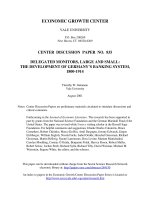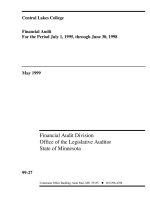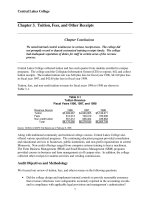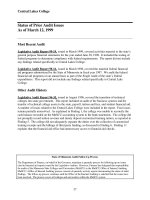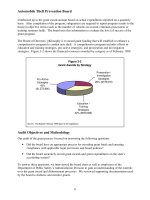Financial security of Vietnam commercial banking system for the period 2010-2017: Current situation and recommendations
Bạn đang xem bản rút gọn của tài liệu. Xem và tải ngay bản đầy đủ của tài liệu tại đây (351.16 KB, 9 trang )
Journal of Science Technology and Food 20 (1) (2020) 17-25
FINANCIAL SECURITY OF VIETNAM COMMERCIAL
BANKING SYSTEM FOR THE PERIOD 2010 - 2017:
CURRENT SITUATION AND RECOMMENDATIONS
Tran Van Hung
Ho Chi Minh City University of Food Industry
Email:
Received 20 December 2019; Accepted 28 February 2020
ABSTRACT
The article reflects the reality of the financial security of Vietnam's commercial banking
system in the period of 2010-2017. Based on secondary data collected from the report of the
State Bank and based on financial security measurement indicators of the banking system,
namely four typical indicators were the bad debt ratio, profitability, capital adequacy ratio, the
ratio of outstanding loans to total deposits.The research results showed that in the period of
2010-2017, although Vietnam had controlled the financial security indicators of the
commercial banking system, there were still potential risks, especially in credit operations. In
particular, the bad debt ratio is still high, financial and monetary supervision was not effective,
so it had not contributed much to the security and financial safety of the whole system. Based
on that, the article proposes a number of recommendations to enhance financial security in
banking operations.
Keywords: Financial security, commercial banking, current situation.
1. INTRODUCTION
Financial security is becoming increasingly a vital issue for each country, especially in
the context of rapid globalization and economic - financial liberalization. Financial security
assurance means ensuring the operation of the financial system in a stable, safe and strong
manner. For Vietnam, a country that is transitioning to a socialist-oriented market economy,
the more important it is to ensure financial security as one of the prerequisites for economic
development with high speed and stability [1]. In particular, the banking system is an important
part of the financial system, playing an extremely important role in the economy with the main
function of mobilizing and allocating resources in the economy. In the context of deeper and
deeper international economic integration, the instabilities of the world financial markets
directly affect the management of exchange rates, interest rates, national debts, inflows of I/O
as well as risks of Vietnamese financial institutions on the financial market. If the operation
of the banking system is not effective, high risks can easily lead to monetary and financial
crises and adversely affect social-economic development. Therefore, ensuring financial and
banking security in the trend of globalization and financial liberalization is always a matter of
current concern. From that, the objective of the article is to present the current state of financial
security of Vietnam's banking system and proposes a number of recommendations to enhance
financial security in banking operations.
17
Tran Van Hung
2. THEORETICAL BASIS
2.1. The concepts of financial security for banking activities
Currently, there are many different concepts of financial security but according to some
scholars have the following outstanding concepts:
Financial security for the operation of credit institutions is the assurance of capital safety,
operational safety, and asset status (liabilities, assets and net assets) of credit institutions are
implemented in a stable, safe and strong manner [2].
Financial security for the activities of credit institutions in general and banks in particular
is the use of measures to keep their assets always stable and safe, strong and not in crisis [1].
The serious financial threat to banks is a liquidity risk and liquidity risk of banks also
reflects the stability of financial markets [3].
Thus, financial security for banking activities is to ensure the safety of the assets of banks,
which are always stable, safe and strong.
2.2. The indicators measuring financial security of the banking system
Currently, there are two common indicators for measuring risks of the financial system,
including:
Firstly, the indicator system of the European Central Bank (ECB). In particular, the
system of macro safety indicators (Macro Prudential Indicators - MPIs) to assess the financial
stability of the banking sector; MPIs includes many indicators, some of them measure the
financial stability (FSIs), but mainly focuse on the stability of the European common bank.
Secondly, the Asian Development Bank (ADB) system of indicators has set up a prudent
monitoring indicator system consisting of 67 basic indicators and 43 sub-indicators which are
divided into 7 groups: External debt and financial flows; Currency and credit; Bank; Interest
rate; Stock market and bonds; Trade; Exchange rate and foreign exchange fund; Statistical and
business data.
In Vietnam, the assurance of financial safety in the financial market is done through the
criteria of financial safety supervision in the monetary market - banking, stock market and
insurance market [2]. For the currency market - Banking: International standards according to
Basel II and the CAMELS indicator system are used to ensure safety in banking operations.
Thus, the financial security in the operation of commercial banks is affected by many
factors. Within the scope of this article, the author assesses the safety and robustness in the
operation of the commercial banking system in Vietnam for the period of 2010-2017 based on
a number of basic criteria: Bad debt indicators; Profitability criteria; Capital adequacy ratio;
Loan outstanding ratio, because these are the basic indicators showing the financial risks of
commercial banks [4].
3. RESEARCH METHOD
3.1. Research data
Data used in this research are from the annual report of the State Bank in the period of
2010 - 2017, namely data on the ratio of bad debt, profitability, capital adequacy ratio, debt
ratio to loans to total deposits of commercial banks and data on the ratio of bad debts to total
outstanding loans of Vietnam compared to other countries for analysis and evaluation.
18
Financial security of Vietnam commercial banking system for the period 2010-2017...
3.2. Analytical methods
The article uses a descriptive statistical method, combined with illustrated tables to assess
the financial security situation of the Vietnamese commercial banking system.
On the basis of secondary data source, 4 indicators reflecting the financial security
situation of the banking system have been analyzed.
4. THE REALITY OF FINANCIAL SECURITY OF VIETNAM'S COMMERCIAL
BANKING SYSTEM IN THE PERIOD OF 2010 - 2017 THROUGH A NUMBER OF
BASIC CRITERIA
NPLs (Nonperforming loan - NPL):
In Vietnam, the concept of bad debt is now regulated by the State Bank according to the
consolidated document No. 01/VBHN-NHNN dated 31/3/2014 [5]. NPLs of banks include
loans of group 3 (substandard debt), group 4 (doubtful debts) and group 5 (potentially
irrecoverable debts) is specified in Article 10 of the Circular. The bad debt ratio is the ratio of
bad debt to total debt from group 1 to group 5, which shows the percentage of loans that the
borrower fails to fulfill its debt repayment obligations to the bank goods as committed. During
this period, many commercial banks were converted from rural banks or newly established
with small equity scale and were forced to mobilize capital in the inter-bank market because
there is no basis for strong depositors to boost lending. The over-reliance on so-called market
2 to raise capital has led many banks to lose liquidity when the State Bank tightened monetary
policy to fight inflation in 2008-2009.
Figure 1. NPL ratio of Vietnamese commercial banks [6]
The period of 2011-2014 was a hot spot for bad debt, this index was higher than 3%,
especially in 2012, reached the highest of 8.82%. During this period, bad debts concentrated
in the area of real estate and stock. Also according to the State Bank, in 2012 bad debts of
state-owned enterprises and state-owned economic groups accounted for 70% of the total bad
debts. From 2015 onwards, NPLs tended to decrease and were below 3%.
Compared with other countries in the region, the NPL ratio of Vietnam is still quite high.
Vietnam's bad debt methodology has not followed international standards to correctly identify
the level of risk to the monetary and banking market. Conventional calculations always show
that the reported debt of commercial banks is much lower than the international standard. This
poses a challenge to perfect Vietnam's NPL calculation in accordance with international
standards to correctly identify the level of risk to credit safety.
19
Tran Van Hung
Table 1. NPL/total outstanding loans ratio of Vietnam to other countries (%) [7]
Year
2010
2011
2012
2013
2014
2015
2016
Vietnam Singapore
2.1
2.8
3.4
3.1
2.9
2.52
2.58
Malaysia
Thailand
Philippin
Indonesia
China
Japan
3.4
2.7
2.0
1.8
1.6
1.6
1.7
3.9
2.9
2.4
2.3
2.3
2.7
2.9
3.4
2.6
2.2
2.4
2.0
1.9
2.0
2.5
2.1
1.8
1.7
2.1
2.4
3.0
1.1
1.0
1.0
1.0
1.1
1.7
1.7
2.5
2.4
2.4
2.3
1.9
1.6
1.5
1.4
1.1
1.0
0.9
0.8
0.9
1.1
Profitability criteria
This index reflects the performance of commercial banks. Profitability is one of the goals
that both managers and investors pay attention to because high profits will help banks preserve
capital, increase market share and attract investment. A bank with stable growth in profits is
one of the signs showing the bank's sustainable development.
Return on equity (ROE) and return on assets (ROA) are two typical indicators used to
assess the profitability of banks. ROE and ROA ratios depend on the business season as well
as the size and risk level of the bank. According to data from the State Bank, profitability
targets of the commercial banking system (ROA, ROE) for the period of 2010-2017 decreased
over the years. ROA in 2010 was 1.1%, in 2017 it was 0.62%, ROE in 2010 was 13.4%, down
to 7.79% in 2017. Although the indicators reflect the size of the bank such as equity, total
customer deposits, outstanding loans increased, profit targets decreased. This reflects the
inefficient use of commercial banks.
Figure 2. Profitability of Vietnamese commercial banking system [6]
Capital Adequacy Ratio (CAR)
This is an indicator reflecting the financial capacity specified in the Basel standard. CAR
is also an important indicator to ensure capital adequacy and assess the ability of commercial
banks to resist risks according to the orientation of the State Bank of Vietnam.Currently, the
capital adequacy ratio of banks is regulated in Circular 36/2014/TT-NHNN dated November
20, 2014 providing limits and prudential ratios in operations of credit institutions, foreign bank
branches. However, compared to Basel II, the minimum safety factor in Vietnam did not
mention the market risk and operational risk. By December 2016, the State Bank issued
Circular 41/2016/TT-NHNN regulating capital adequacy ratios for banks and foreign bank
branches. This circular has the content of adjustment according to Basel II, whereby the CAR
ratio decreases from 9% to 8%, and the formula for CAR calculation is also amended.
20
Financial security of Vietnam commercial banking system for the period 2010-2017...
Compared with other countries in the region, the capital adequacy ratio of Vietnamese
commercial banking system is quite low, as shown in the following Table 2:
Table 2. Capital adequacy ratios of some ASEAN countries in 2019 [8]
Countries
CAR (%)
Cambodia
22.0
Indonesia
23.3
Malaysia
17.7
Philippin
15.9
Singapore
16.7
Thailand
Viet Nam
19.4
13.3
In general, the financial system ensures a good ability to provide capital to the economy
and has met the minimum capital adequacy ratio of 9% under the effective Circular No.
36/2014/TT-NHNN. By the end of 2017, capital supply to the economy from the financial
system was estimated at 198% of GDP, an increase of 28.6% compared to the end of 2016. In
particular, capital from the credit institution system increased by 18.1%, leading to CAR ratio
of commercial banks reached 10.65%. In particular, joint venture commercial banks and
foreign branches have CAR twice higher than other groups. This is explained by the fact that
these banks have just applied the capital adequacy ratio prescribed by Vietnam, and also follow
the standards of the country where the head office is located and how to calculate the CAR
ratio of the banks. This bank is mostly rated to meet Basel II.
40
33,8
35
30
33,4
33,2
31,12
27,63
26,55
25
20
15
13,75 14
13,25 12,56
12,94
13 12,74
11,75
12,84 11,8
11,1
12,7
10
5
0
2012
2013
2014
2015
2016
2017
The financial system ensures
State-owned commercial banks
joint-stock commercial bank
Joint venture commercial banks
and foreign branches
Figure 3. Capital adequacy ratio of Vietnam financial and credit system for the period 2010-2017 [6]
In general, the CAR of Vietnamese credit institutions is in the safe range, but there are
some points to note:
(i) Although the Vietnamese commercial banks have made every effort and most have
achieved capital adequacy ratios above 8%, if compared with the calculation of the safety
coefficient of Basel II, the denominator must be added to the capital for market risks and
21
Tran Van Hung
operational risks, very few Vietnamese commercial banks will surely achieve capital adequacy
ratio above 8%.
(ii) State-owned commercial banks have the lowest CAR system among credit
institutions. This is a group of large-scale banks, accounting for more than 40% market share
of deposits and loans but with a low CAR
(iii) A number of banks have increased their legal capital levels to ensure the minimum
capital adequacy ratio. But many banks are still in the process of implementing plans to
increase their legal capital. Therefore, the minimum capital adequacy ratio of the whole
banking system has increased, but it has not yet guaranteed an increase according to the
minimum capital adequacy ratio.
The noticeable problem at this stage is due to the impact of the stimulus policy as well as
the implementation of monetary easing by the SBV, so the credit at commercial banks has
increased sharply. This has led to an increase in the total risk assets of commercial banks and
as a result, commercial banks in the above group tend to reduce their capital adequacy ratio.
Loan to deposit ratio (LDR)
This is one of the safety ratios used by many countries. This ratio reflects the relationship
between lending and deposit as a measure of liquidity, so as the LDR increases, the liquidity
of the bank decreases accordingly. In Vietnam, LDR is specified in Circular 06/2016/TTNHNN, and the maximum rate is 80%-90% depending on the type of commercial bank.
In fact, the LDR ratio in the period of 2010-2017 was above 80%, particularly in 2011,
LDR was highest ratio in this period when reached 95.83%, and the reason was that during
this period, Commercial banks are in serious liquidity shortage. Since then, in order to meet
the demand for credit for customers and other liquidity needs, banks have mobilized deposits
with very high interest rates of 18% per year, exceeding the ceiling set by the State Bank of
14% / year. Since 2012, the LDR ratio has been controlled below 90%. However, as suggested
by the International Monetary Fund (IMF, 2000), banks need to reduce this ratio to less than
65% to avoid the liquidity burden in order to cope with shocks.
100
95,83
95
88,85
90
85
87,96
85,69
87,74
84,47
81,78
80,37
80
75
70
2010
2011
2012
2013
2014
2015
2016
2017
LDR (%)
Figure 4. Ratio of outstanding loans to total deposits of Vietnam's commercial banking system
for the period 2010-2017 [6]
Compared with other countries in the region, a telling gauge of banks’ exposure to higher
interest rates, paints a broadly positive picture for ASEAN, although not without exceptions.
LDR's of most major ASEAN banks, with the exception of Thailand and Malaysian banks,
stand at comfortable levels compared to rest of the world. Thailand banks top the region with
LDR levels near or above 100% while Philippines banks’ have the lowest LDR levels at 69%.
22
Financial security of Vietnam commercial banking system for the period 2010-2017...
The broad picture is more encouraging with ASEAN banks average LDR levels at 84%
compared to 98% for the rest of the world and 90% for the developed world.
Table 3. Loan to deposit ratio of some ASEAN countries in Q3/2015 [7]
Countries
LDR (%)
Singapore
82.5
Malaysia
94
Indonesia
81
Thailand
99
Philippin
69
Việt Nam
73
By analyzing the financial security situation of Vietnam commercial banking system in
the period of 2010-2017 through a number of indicators show that although Vietnam has
control of the financial security indicators of the system commercial banks, but still have many
potential risks, especially in credit activities, in particular, the bad debt ratio is still high,
financial and monetary supervision has not been effective, so it has not contributed much to
the security and financial safety of the whole system.
5. SOME SUGGESTIONS AND RECOMMENDATIONS
Despite remarkable achievements, Vietnam's economy in general and the banking and
financial system in particular are still facing many difficulties. In particular, Vietnam may face
risks in terms of financial safety, especially related to bad debts. From the above-mentioned
financial security situation, some recommendations to policy makers to enhance financial
security in banking operations are as follows:
Building an appropriate financial supervision mechanism: in order to minimize risks in
banking business activities to contribute to financial security, the State Bank should classify
commercial banks into groups and issue Financial targets for each specific group. At the same
time, it is necessary to promptly handle weak-performing banks to ensure their own business
and to avoid a chain effect on other banks.
Complete the legal framework on liquidity risk management for the system: currently,
the law only regulates liquidity risk management of each commercial bank but there is no
regulation to adjust risk management liquidity of the whole banking system. Therefore,
measuring and giving warnings about the possibility of systematic liquidity risk for the whole
commercial banking system is really necessary. In order to do this, the law needs to stipulate
the development and determination of a system of liquidity indicators for the commercial
banking system, which is considered as a standard to help bank administrators to cope timely
and prevent a possible liquidity crisis.
Develop a system to assess the ability of commercial banks to resist risks: building a
system to assess the resilience of commercial banks to shocks in the financial market is really
necessary to adopt financial security indicators to help policy makers and financial institutions
proactively cope with risks.
Enhancing the competitiveness of commercial banks: Vietnam's commercial banking
system needs to improve its competitiveness to meet the requirements of stable and effective
23
Tran Van Hung
development in accordance with international standards and practices such as Camels, Basel
II, Basel III adopt a number of measures such as:
Increasing the charter capital: It is the most important factor to ensure the minimum
capital adequacy ratio prescribed by the State Bank and also ensures the safety for the
operation of the bank itself during its operation credit activity. Increasing capital will allow
banks to invest in technology development, human resource training and expansion of
distribution channels.
Technology development investment: In a modern competitive environment, technology
is an important factor affecting the success of banks. Along with increasing equity, commercial
banks need to upgrade investment in developing modern technology capable of linking in the
system, in order to enhance competitiveness against the trend of competitive commercial
banks.
Improving the quality of human resources: There are policies to encourage officials and
employees in the bank need to improve professional qualifications; send those who have good
management capacity to study and learn how to work, organize and manage in developed
countries in the world.
REFERENCES
1. Vu Dinh Anh - Financial security in banking activities, Ha Noi (2017)
/>OaT_doNG_NGaN_HaNG.pdf
2. Le Thi Thuy Van - Solutions to ensure financial security in Vietnam's financial
market, 2017. />3. Tavana M., Abtahi A.R., Caprio D.D., Poortarigh M. - An artificial neural network
and Bayesian network model for liquidity risk assessment in banking,
Neurocomputing 275 (2018) 2525-2554.
4. Hung Truong Anh, H. N. - Applying a set of safety supervision criteria for banking
operations in risk identification of credit institutions and foreign bank branches,
Banking Magazine 24 (2018).
5. The state Bank of Viet Nam - The consolidated document No. 01/VBHN-NHNN dated
31/3/2014
6. The state Bank of Viet Nam - Annual report from 2010 to 2017, Information and
communications publishing house.
/>3296591577#%40%3F_afrLoop%3D35665613296591577%26centerWidth%3D80
%2525%26leftWidth%3D20%2525%26rightWidth%3D0%2525%26showFooter%3
Dfalse%26showHeader%3Dfalse%26_adf.ctrl-state%3D1dib5l8vyd_115
7. Sumedh Deorukhkar, Le Xia - ASEAN Deciphering the region’s banking sector,
BBVA Research (2015) />12/10-Dec-2015_Banking-Watch_ASEAN_BBVA.pdf
8. />
24
Financial security of Vietnam commercial banking system for the period 2010-2017...
TÓM TẮT
THỰC TRẠNG AN NINH TÀI CHÍNH
CỦA HỆ THỐNG NGÂN HÀNG THƯƠNG MẠI VIỆT NAM GIAI ĐOẠN 2010 - 2017:
THỰC TRẠNG VÀ KHUYẾN NGHỊ
Trần Văn Hùng
Trường Đại học Công nghiệp Thực phẩm TP.HCM
Email:
Bài viết nêu lên thực trạng an ninh tài chính của hệ thống ngân hàng thương mại Việt
Nam trong giai đoạn 2010-2017. Dựa trên nguồn dữ liệu thứ cấp thu thập từ báo cáo của ngân
hàng nhà nước và dựa trên các chỉ tiêu đo lường an ninh tài chính của hệ thống ngân hàng, cụ
thể là bốn chỉ tiêu điển hình là tỷ lệ nợ xấu, khả năng sinh lời, tỷ lệ an toàn vốn, Tỷ lệ dư nợ
cho vay so với tổng tiền gửi. Kết quả nghiên cứu cho thấy trong giai đoạn 2010-2017 mặc dù
Việt Nam đã kiểm soát được các chỉ tiêu về an ninh tài chính của hệ thống ngân hàng thương
mại nhưng vẫn còn tiềm ẩn nhiều rủi ro nhất là trong các hoạt động tín dụng, mà cụ thể là tỷ
lệ nợ xấu vẫn còn cao, hoạt động giám sát tài chính tiền tệ chưa hiệu quả nên chưa đóng góp
nhiều cho công tác đảm bảo an ninh, an toàn tài chính của toàn hệ thống. Trên cơ sở đó, bài
viết đề xuất một số khuyến nghị nhằm tăng cường an ninh tài chính trong hoạt động ngân
hàng.
Từ khóa: An ninh tài chính, ngân hàng thương mại, thực trạng.
25

